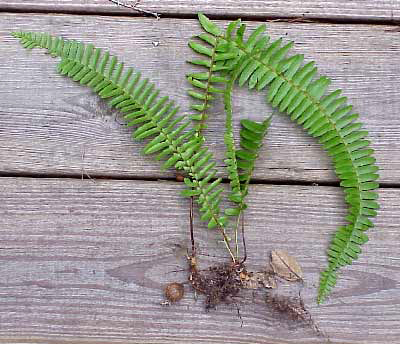Tuberous Sword Fern/Boston Fern (Nephrolepis cordifolia)
The Tuberous Sword Fern swarms our landscapes and is easily found at many nurseries around the county. It goes by many names, including Boston Fern. You can easily confuse the tuberous sword fern with the native sword fern (N. exaltata). The two plants look nearly identical, but the tuberous sword fern disrupts and displaces many plant communities throughout Florida – including Nassau County. Many homeowners will buy this plant at a local nursery, which then spreads it to the local environment and spreads rapidly.
The key to identifying the native versus invasive fern is to look for the tubers, or little “nuts”, on the roots of the ferns. If you pull some ferns up in your landscape and see the tubers, you have the invasive plant. This plant spreads rather aggressively and continues to propagate from any tubers left in the ground. Without control, this plant will smother and replace many of the plants in your landscape.

Control
Preventative
The first method in controlling tuberous sword fern is by avoiding purchasing, selling, transporting, or trading this plant. Therefore, be aware, most of the sword-type ferns sold within nurseries are tuberous sword ferns. If you would like to purchase sword fern for your landscape, purchase the native species from a reputable native nursery.
Cultural/Physical
Plant the native species or alternative plants. My favorite alternatives include Leatherleaf Fern (Rumohra adiantoformis), Southern Woods Fern (Thelypteris kuntii), and Autumn Fern (Dryopteris erythrosora). If you notice the invasive tuberous sword fern generating spores on the underside of the fronds, make sure you clean your hands and avoid contact to help prevent unintentional spread.
Mechanical
Hand removal of this invasive is relatively easy to do, but any residual tubers left in the ground become a source of another fern to grow. Therefore, once you hand remove a large area of the sword fern, be sure you follow up regularly to remove any other ferns that pop up. Over time you will be able to get control of this invasive plant.
Biological
There are no known biological controls.
Chemical
If the following control methods fail to work, applications of glyphosate are effective. Additionally, follow-up applications may be necessary for complete control.
Conclusions
The tuberous sword fern spreads aggressively across the landscape. Therefore, if you or someone you know is having issues managing this invasive or any other invasive plants within your landscapes, reach out to your county extension office for more information. The invasion of the landscape snatchers has begun, but we can stop it!
More Information:
Blog Series
Like what you are reading? Therefore, check out all the published blogs in this series. https://blogs.ifas.ufl.edu/nassauco/tag/invasion-of-the-landscape-snatcherss/
Or quickly jump to the individual blogs in the series:
Invasion of the Landscape Snatchers
Tuberous Sword Fern (Nephrolepis cordifolia)
Coral Ardisia (Ardisia crenata)
Wild Taro (Colocasia esculenta)
Mexican Petunia (Ruellia simplex)
Mother of Millions (Kalanchoe x houghtonii)
Mimosa Silk Tree (Albizia julibrissin)
Social Media Pages:
Other Media Pages
- Blog Page
- Nassau County Extension Page
- IFAS Assessment
- Center for Aquatic and Invasive Plants
- Contact Information
 1
1
